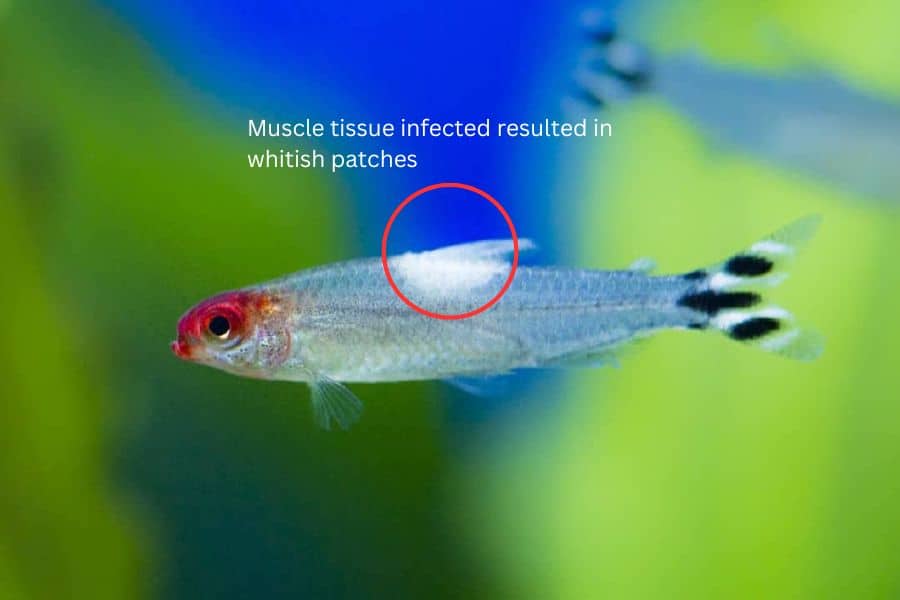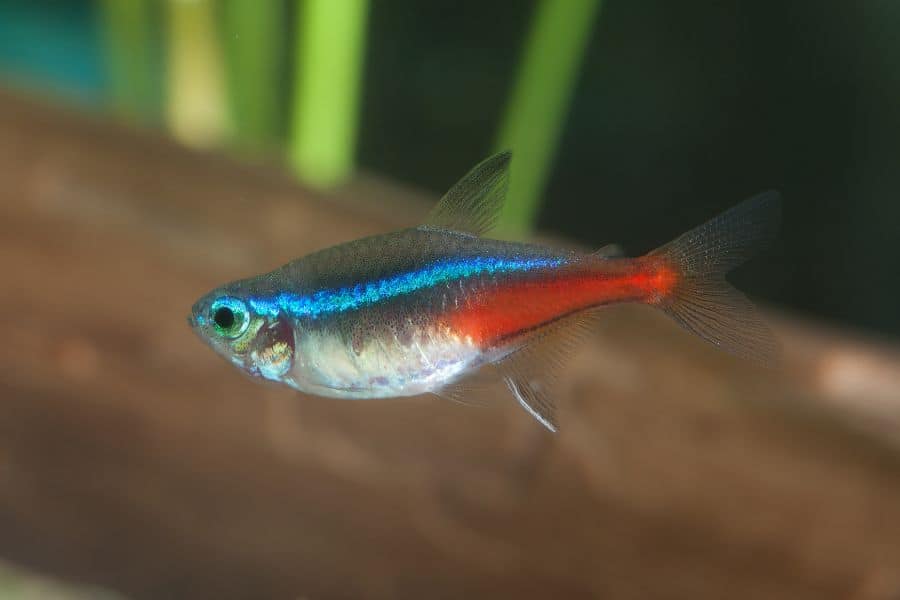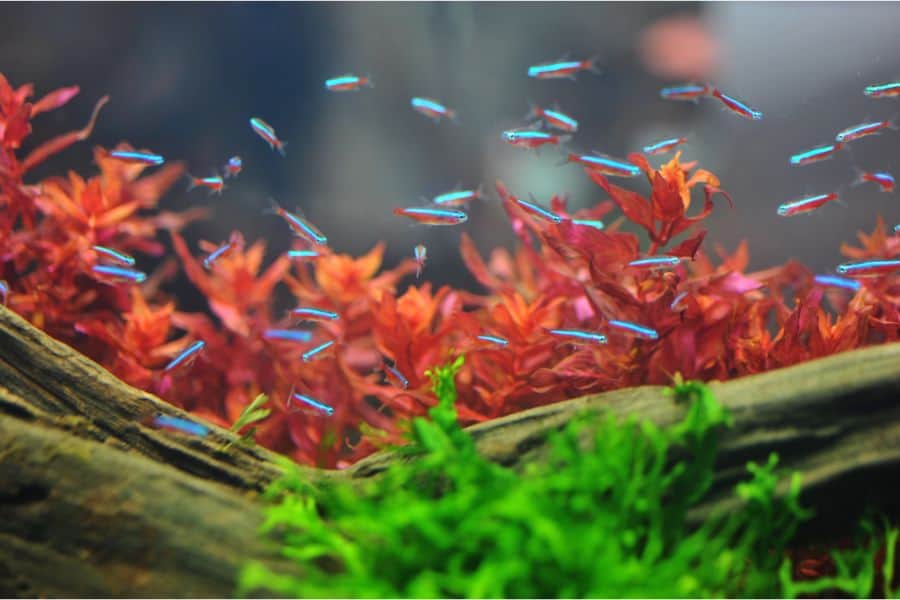Neon tetra disease (NTD) is among the deadliest fish diseases since it has no cure, and fish found with this disease are usually euthanized to avoid an outbreak and to spare the fish from the debilitating symptoms.
On the brighter side, neon tetra disease is easily preventable since its symptoms, causes, and spread are well known. In fact, the disease is very rare once you have all the good prevention measures in place.
You may not be able to save an infected fish, but you can save your fish community from falling prey to the disease.
Read on to learn what the neon tetra disease is, how it is transmitted from one source to another, how it came to be so popular and fatal, and how to treat fish afflicted by the disease. Get to learn of all the symptoms you should keep an eye on and deal with as soon as possible.
How the Neon Tetra Disease Affects Fish
So, what is the neon tetra disease?
It is not a disease that only affects neon tetras, however, it is more prominent in this species and other types of tetras.
The Neon Tetra disease, also known as the pleistophora disease, is caused by microsporidian parasite spores from the Pleistophota hyphessobryconis parasite.
These are tiny spore-forming parasites that cause a lot of untreatable diseases whose symptoms can be similar to those of mycotic diseases of fish.
These spores are spread from the parasites to new fish in a few ways:
- Fish eat live foods that are infected with the spores or the parasites themselves
- Fish can also get the disease when they eat other fish that are already infected
- Infected fish spread the disease to other fish through birth, contact with damaged skin, or bodily contact with gills.

The Pleistophora hyphessobryconis spores infect the skeletal muscle tissue of the fish, which almost immediately dies off, leading to the development of cysts (big whitish lumps), emaciation, and ultimately death.
Infected fish may display symptoms such as loss of color, loss of appetite, decreased activity levels, and curved or deformed spines. As the disease progresses, the infected fish may become emaciated and eventually die.
According to a case study on the mortality of neon tetras after infection, it was discovered that heavy infections caused by the Pleistophora parasite resulted in visible whitish patches beneath the skin as muscle fibers are replaced.
The life cycle of microsporidians typically involves three phases:
- infectivity, during which the spores are injected into a host cell through polar tube extrusion
- proliferation, or merogony, where the number of certain cells rapidly increases, causing cell division and cell growth.
- Sporulation, or sporogony, this is the final stage where more and more spores get formed causing more division into a huge number of small spores
In the study, the fish’s muscle fibers were found to contain anywhere from 2 to 30 parasites in different stages of development, including spore vessels containing spore mother cells and more mature spores.
The infection & death rate is about 70% of any fish farm/aquarium and a community in the wild. This is a high infection rate which makes it very difficult to cure the disease, let alone contain it. It also doesn’t help that the spores can thrive in water for months. There is no known cure for neon tetra disease.
You may now be wondering how long it takes for neon tetra disease to kill your fish. Sadly, once your fish has contracted the disease and the symptoms start showing, it is only a matter of two to eight weeks before they pass away.
Prevention is the best approach to managing this disease. Keeping your aquarium clean and maintaining good water quality, avoiding overcrowding, and quarantining new fish before introducing them to your tank can all help prevent neon tetra disease from spreading.
It is important to involve a laboratory test in case of an outbreak so as to not confuse the neon tetra disease with other prevalent ailments like columnaris and the false neon tetra disease; more on the false NTD later in this article.
History of The Neon Tetra Disease
Many aquarists believe that neon tetras are very sensitive fish that should be cared for by expert hobbyists, but this couldn’t be further from the truth. Neon tetras are pretty resilient, which makes them an aquarist’s favorite, but they are also popular due to their bright, mesmerizing coloring.
Did you know that over 1.8 million neon tetras are imported into the United States each month? That is over $170,000 in aquarium trade imports from different regions in the world, including Southeast Asia and South America. On top of that, the total sales per month in the United States alone is over 2 million.
The popularity of neon tetras is one of the main factors that contributed to the wide spread of neon tetra disease.
| Common Names | Neon tetra |
| Scientific Name | Paracheirodon innesi |
| Natural Habitat, Origin, and Distribution | Freshwater fish native to the Amazon basin in blackwater and clearwater rivers of South America – mainly in Colombia, Peru, and Brazil.
It is highly farm-raised in Singapore, West Java – Indonesia, and other parts of Southeast Asia. |
| Adult Size | Approximately 1.5 inches |
| Color | Typically, a silver to white abdomen with a blueish back. Has an almost transparent body with visible iridescent blueish/greenish stripes and a red band spread across its frame. |
| Lifespan | Typically, two to four years but can live up to 10 years |
| Breeding | Egg laying, externally fertilized & hatched. Difficult to breed in home aquariums. |
| Diet | Omnivorous, mostly flake foods, also brine shrimp & bloodworms |
| Compatible tankmates | Guppies, dwarf gourami, hatchet fish, zebra danios, and rasboras. |
| Ideal water hardness | 1 -2 dKH, below 20 ppm of nitrate |
| Ideal tank size | At least 15 gallons |
| Ideal pH levels | 6.0 – 8.0 |
| Ideal Temperature range | 70 – 82 degrees Fahrenheit |
The neon tetra is a very hardy fish comparable to the rasboras and danios. It is an easy recommendation for beginners in the aquarium hobbyist business because of its hardiness, but it was due to its hardiness that the neon tetra disease came to stand out as much as it did.
If your neon tetra gets severely sick, then there is a high chance that it is suffering from this debilitating ailment. They are easily attacked by parasites, especially when their immune system is weakened, and they are facing some form of stress in the tank.
Once the disease started to spread, it became harder to contain it because neon tetras are kept in large numbers and made it harder to contain it.
The discovery of neon tetras began with Auguste Rabaut in the 1930s when he noticed the species in Peru during a butterfly expedition. He transported the fish to Paris and sold them for more than $6,000, and the species was later dispatched to the United States in mid-1930s.
During this trade, it was discovered that many of the tetras died because of this microsporidian infection, which was later named the ‘neon disease’. The discovery demonstrated that it was important to maintain good water hygiene to keep the disease at bay.
It is thanks to the knowledge gained from observing and working with neon tetra during these early periods that it is now possible for us to successfully keep and breed a wide variety of delicate species in aquariums. You would think that regular maintenance was obvious, but this was not the case during that time.
With that said, can neon tetra disease spread to other types of fish? Yes, it was discovered that other fish were susceptible to the NDT but not as frequently as the neon tetras.
Other fish that are commonly attacked by neon tetra disease include:
- All types of tetra fish like the ember tetra, Congo tetra, rummy nose tetra, bloodfin, and green neon tetra.
- Angelfish
- Barbs
- Danios
- Zebrafish
- Rasboras
- Guppies
Symptoms of Neon Tetra Disease & How to Diagnose Your Fish
Please remember, the symptoms of the true neon tetra disease won’t help you differentiate it from the false neon disease in a home aquarium. It is also easy to misdiagnose NDT as other types of parasitic or bacterial infections.
These diseases share many signs & symptoms from the loss of color on the fish to restlessness, cysts, and swimming difficulties. However, it is crucial to always keep an eye on the symptoms. Please get a professional to use laboratory test kits to identify the true NDT. False neon tetra disease can easily be cured by applying broad-spectrum antibiotics.
- Swimming Difficulties and Restlessness: These are the first signs, and any changes in the swimming pattern of the fish should be a cause for concern that you should take note of.
- Neon Tetra Losing Color & Development of a Neon Tetra White Spot: Once the fish is at this stage the disease has advanced with attacks on the skeletal muscles. Localized fading like a white spot is the first distinct sign of the NDT since it is situated in specific parts of the body, losing muscles.
- Cysts & Lumps Typically faded or white in color. It is a sign that the disease is eating away the intestinal walls.
- Immobility & Not Eating: As the disease becomes fatal, the spine of the fish becomes curved due to weakened muscles. This causes the fish to have difficulty moving, search for food, or swim up and about. The fish becomes more stressed, spending most of its time in hiding and its weight will drastically reduce at this stage.
Contributors to The Neon Tetra Disease
There are only three contributors to the spread of the neon tetra disease:
- Poor water quality and water parameters
- Poor Breeding Grounds, especially from online retailers and commercial fish farms that keep them in large numbers due to their high demand, mistakes like mixing different stocks are easily made.
- Stressful conditions. Please pay attention to these factors to know whether your neon tetra is stressed to reduce the chances of its contraction of the disease:
- Aggression from larger tankmates. This will be characterized by frequent darting of the fish from one end of the tank to the other. You will also notice that your neon tetras are hiding more often than they normally do.
- Your neon tetras are not eating normally
- Weight loss
Preventive Measures to Get Rid of The Neon Tetra Disease
Since there is no cure, we rely on these preventive measures to cut down the spread of the disease:
- Separate the infected fish from the ones that are healthy
- Do not buy fish you suspect to be suffering from the diseases. It is important to pay keen attention to the symptoms and the history of the given fish stock. Looking at reviews online from the store is a good place to start.
- Always quarantine new fish before introducing them to your main aquarium tank community.
- Prevention is better than a cure. To prevent fish infection, there are several common practices to consider:
- Firstly, changing 20% of the water weekly is recommended.
- It is also important to maintain adequate temperature and pH levels.
- Utilize water test kits, filters, and heaters to meet your fish’s basic environmental needs.
- Keep your water quality and parameters at a high level to prevent your fish from contracting major diseases including the neon tetra disease.
- Use diatom filters to prevent the accumulation of free-floating parasites in the aquarium water.
Also Read:
- Why Your Fish Keep Dying?
- Goldfish Turning White
- Popeye Fish Disease
- Common Guppy Diseases
- Fish Dying After Water Change
- What Is Ich on Fish? Symptoms & Treatment
FAQs
What Does a Sick Neon Tetra Look Like?
Many diseases can attack a neon tetra fish, not just the common NDT. To identify a sick neon tetra, look at these symptoms:
- Swimming difficulties
- Weight loss
- Restlessness and erratic behavior
- Fish discoloration
- Curved spines
- Bloating
- The fish-eating less and developing white lumps on muscle – are more common when the disease has become severe
What Diseases Can Neon Tetras Have?
Apart from the pleistophora neon tetra disease, these fish also suffer from the common ich disease, bacterial infections, skin flukes, and they also suffer from water shock due to stress & agitation,

